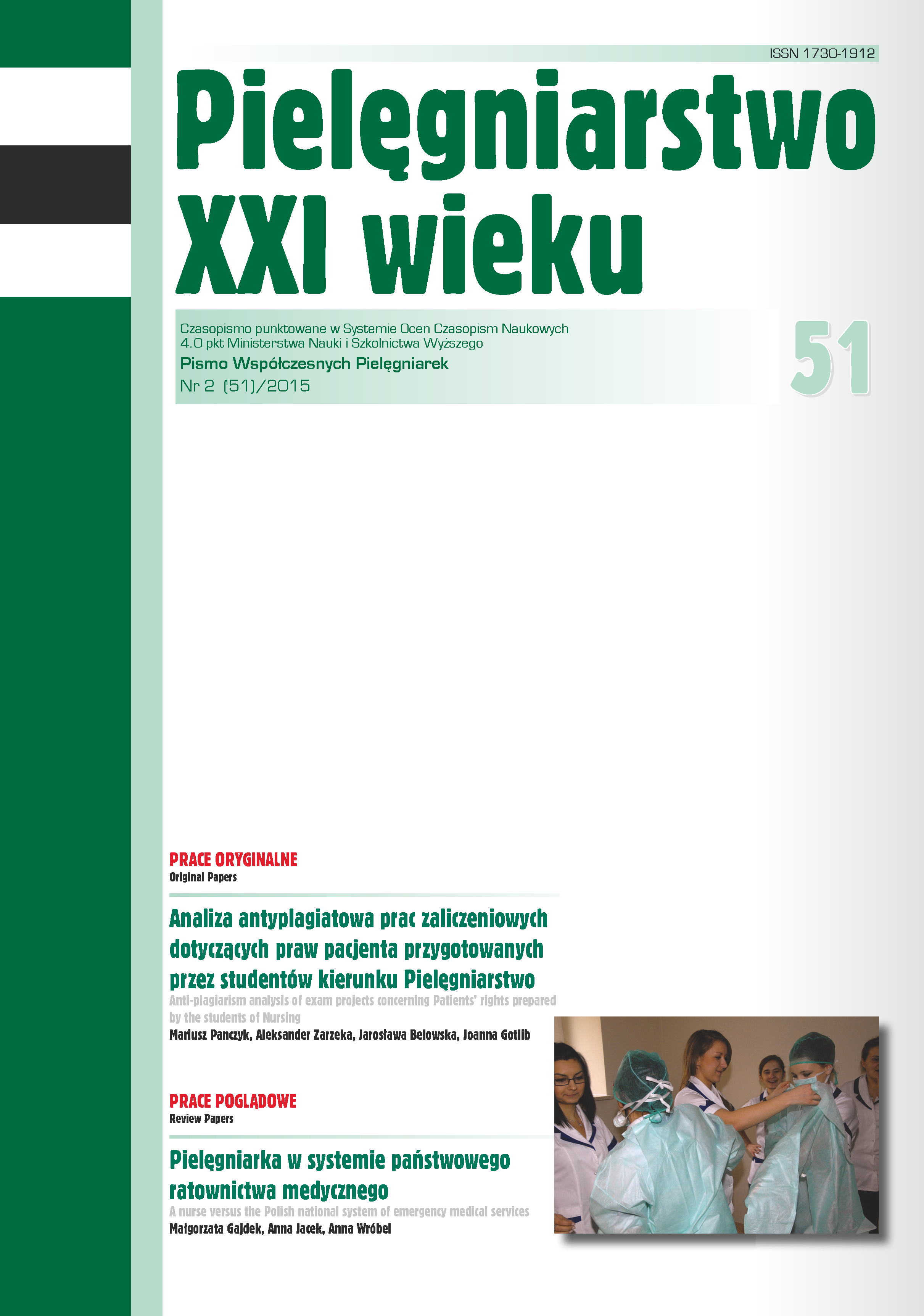Zespół wypalenia zawodowego wśród personelu pielęgniarskiego zatrudnionego w oddziałach intensywnej terapii
DOI:
https://doi.org/10.12923/p21w-2015-2/20Słowa kluczowe:
wypalenie zawodowe, oddział intensywnej terapii, personel pielęgniarskiAbstrakt
ZESPÓŁ WYPALENIA ZAWODOWEGO WŚRÓD PERSONELU PIELĘGNIARSKIEGO ZATRUDNIONEGO W ODDZIAŁACH INTENSYWNEJ TERAPII
Wstęp. Pracownicy ochrony zdrowia są narażeni na występowanie zespołu wypalenia zawodowego (ZWZ).
Cel pracy. Celem pracy była ocena występowania ZWZ wśród pielęgniarek w oddziałach intensywnej terapii (OIT).
Materiał i metody. Badaniami objęto 195 pielęgniarek. Udział w badaniu był dobrowolny i anonimowy. W badaniu wykorzystano standaryzowany kwestionariusz ankiety: 36 stwierdzeń w 7 stopniowej skali Likerta. Statystyka opisowa: średnia, odchylenie standardowe, min, max.
Wyniki. Największy wpływ na poziom ZWZ miało obciążenie pracą, średnia 46,14 w Grupie 1 i 47,18 – w Grupie 2, stosunek do pracy – średnia: 40,92 (Grupa 1) i 40,43 (Grupa 2) oraz kontakt z pacjentem – średnia 30,85 (Grupa 1) i 29,14 (Grupa 2). Najniższe wyniki uzyskała postawa wobec stresu ze średnią 17,71 w Grupie 1 i 17,36 w Grupie 2. Najwyższe wyniki uzyskał pediatryczny personel pielęgniarski.
Wnioski.
- Pielęgniarki zatrudnione w oddziałach IT są narażone na występowanie ZWZ, co może mieć bezpośredni wpływ na obniżenie jakości opieki nad pacjentem.
- Rodzaj oddziału OIT nie miał wpływu na poziom wypalenia zawodowego.
- Największy wpływ na poziom wypalenia zawodowego w grupie pielęgniarek OIT mają czynniki organizacyjne (obciążenie pracą), co powinno zwrócić uwagę instytucji zatrudniających pielęgniarki w celu modyfikacji rozwiązań organizacyjnych i podniesienia standardu opieki nad pacjentem.
- Płeć nie miała wpływu na występowanie ZWZ w OIT, jednakże porównywane grupy nie były równoliczne, więc zagadnienie to wymaga dalszych badań.
Bibliografia
1. Owczarek K, Olczyk K, Wójtowicz S. Badanie zjawiska wypalenia zawodowego u pielęgniarek pracujących w wybranych oddziałach szpitalnych. Med. Dyd. Wych. 2009; 1: 28-38.
2. Beisert M. Przejawy, mechanizmy i przyczyny wypalania się pielęgniarek W: Sęk H, Wypalenie Zawodowe: przyczyny, zapobieganie. Warszawa: Wyd. PWN; 2010.
3. Owczarek K. Wypalenie zawodowe W: Psychologia dla pielęgniarstwa. Warszawa: Oficyna Wydawnicza Warszawskiego Uniwersytetu Medycznego; 2008.
4. Jakubas-Kolat J. Zjawisko stresu w pracy zespołu anestezjologicznego. Anest. Ratow. 2008; 1: 66-69.
5. Wyderka M, Kowalska H, Szeląg E. Wypalenie zawodowe jako problem występujący wśród pielęgniarek. Piel. Pol. 2009; 4(34): 265-275.
6. Aiken LH, Clarke SP, Sloane DM, et al. Nurses’ Reports On Hospital Care In Five Countries. Health Aff. 2001; 20 (3): 43-53.
7. Bakker AB, Schaufeli WB. Burnout contagion among general practitioners. J Soc Clin Psychol. 2001; 20 (1): 82-98.
8. Lori LA. Burnout: Impact on Nursing. CME Resource 2009, http://www.netcegroups. com/548/Course_3142.pdf, wejście: 18.10.2012
9. Aiken LH, Sloane DM, Bruyneel L, et al. RN4CAST Consortium: Nurses’ reports of working conditions and hospital quality of care in 12 countries in Europe. Int J Nurs Stud. 2013; 5: 143-153.
10. Bakker AB, Le Blanc PM, Schaufeli WB. Burnout contagion among intensive care nurses. J Adv Nurs 2005; 51: 276-287.
11. Hooper C, Craig J, Janvrin DR, et al. Compassion satisfaction, burnout and compassion fatigue among emergency nurses compared with nurses in other selected inpatient specialties. J Emerg Nurs. 2010; 36: 420-7.
12. Verdon M, Merlani P, Pernger T, et al. Burnout in a surgical ICU team. Inten. Care Med 2008; 34: 152-156.
13. Chylińska J, Krupa A, Owczarek K. Poziom wypalenia zawodowego wśród pracowników pogotowia ratunkowego – porównanie różnych grup zawodowych. Med. Dyd. Wych. 2011; 6: 34-38.
14. Maslach C, Schaufeli WB, Leiter MP. Job Burnout. Annu Rev Psychol 2001; 52: 397- 422.
15. Norrie P. Do intensive care staff suffer more stress than staff in other care environments? A discussion. Intensive Crit Care Nurs. 1995; 1: 293-297.
16. Cronqvist A, Theorell T, Burns T, et al. Dissonant imperatives in nursing: a conceptualization of stress in intensive care in Sweden. Intensive Crit Care Nurs. 2001; 17: 228-236.
17. Raggio B, Malacarne P. Burnout in Intensive Care Unit. Minerva Anestesiologica. 2007; 73: 195-200.
18. Anczewska M, Świtaj P, Roszczyńska J. Wypalenie zawodowe. Post. Psych. Neur. 2005; 14 (2): 67-77.
19. Tartas M, Derewicz G, Walkiewicz M, et al. Źródła stresu zawodowego w pracy pielęgniarek zatrudnionych w oddziałach o dużym obciążeniu fizycznym i psychicznym – hospicjum oraz chirurgii ogólnej. Ann. Acad. Med. Gedan. 2009; 39: 145-153.
20. Barczykowska E, Gierszewska M. Specyfika pracy pielęgniarki na oddziale pediatrii. W: Pielęgniarstwo w Pediatrii. Warszawa: Wyd. Medyczne Borgis; 2006.
21. Poncet MC, Toullic P, Papazian L, et al. Burnout syndrome in critical care nursing staff. Am J Respir Crit Care Med. 2007; 175(7): 698-704.
22. Heinen MM, van Achterberg T, Schwendimann R, et al. Nurses’ intention to leave their profession: A cross sectional observational study in 10 European countries. Int J Nurs Stud 2013; 50: 174-184.
23. Aiken LH, Clarke SP, Sloane DM, et al. Nurses’ Reports On Hospital Care In Five Countries. Health Aff 2001; 20 (3): 43-53.
Pobrania
Opublikowane
Numer
Dział
Licencja
Prawa autorskie (c) 2024 Katarzyna Gwarda, Zofia Sienkiewicz, Anna Kaczyńska, Joanna Gotlib (Autor)

Utwór dostępny jest na licencji Creative Commons Uznanie autorstwa 4.0 Międzynarodowe.




